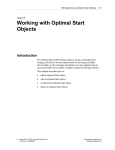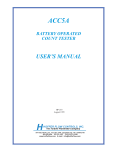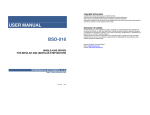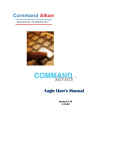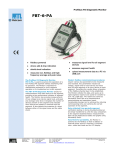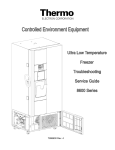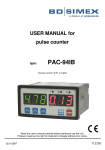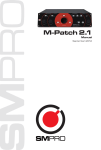Download USER`S MANUAL - Hoffer Flow Controls, Inc
Transcript
MODEL 314i Field Mounted Batch Controller USER’S MANUAL HP-292 May 1998 107 Kitty Hawk Lane, P.O. Box 2145, Elizabeth City, NC 27906-2145 800-628-4584 252-331-1997 FAX 252-331-2886 www.hofferflow.com E-mail: [email protected] HP292 NOTICE HOFFER FLOW CONTROLS, INC. MAKES NO WARRANTY OF ANY KIND WITH REGARD TO THIS MATERIAL, INCLUDING, BUT NOT LIMITED TO, THE IMPLIED WARRANTIES OF MERCHANTABILITY AND FITNESS FOR A PARTICULAR PURPOSE. This manual has been provided as an aid in installing, connecting, calibrating, operating, and servicing this unit. Every precaution for accuracy has been taken in the preparation of this manual; however, HOFFER FLOW CONTROLS, INC. neither assumes responsibility for any omissions or errors that may appear nor assumes liability for any damages that result from the use of the products in accordance with information contained in the manual. HOFFER FLOW CONTROLS' policy is to provide a user manual for each item supplied. Therefore, all applicable user manuals should be examined before attempting to install or otherwise connect a number of related subsystems. During installation, care must be taken to select the correct interconnecting wiring drawing. The choice of an incorrect connection drawing may result in damage to the system and/or one of the components. Please review the complete model number of each item to be connected and locate the appropriate manual(s) and/or drawing(s). Identify all model numbers exactly before making any connections. A number of options and accessories may be added to the main instrument which are not shown on the basic user wiring. Consult the appropriate option or accessory user manual before connecting it to the system. In many cases, a system wiring drawing is available and may be requested from HOFFER FLOW CONTROLS. This document contains proprietary information which is protected by copyright. All rights are reserved. No part of this document may be photocopied, reproduced, or translated to another language without the prior written consent of HOFFER FLOW CONTROLS, INC. HOFFER FLOW CONTROLS’ policy is to make running changes, not model changes, whenever an improvement is possible. This affords our customers the latest in technology and engineering. The information contained in this document is subject to change without notice. HFC 9707 WARRANTY HOFFER FLOW CONTROLS, INC. warrants this unit to be free of defects in workmanship and materials provided that the unit was properly selected for the service intended, properly installed, and not misused. Equipment returned, transportation prepaid, within 12 months after delivery of goods or 18 months from date of shipment for units destination outside the United States and is found by HOFFER FLOW CONTROLS inspection to be defective in workmanship or materials will be repaired or replaced at HOFFER FLOW CONTROLS sole option, free of charge and returned prepaid using the lowest cost transportation. RETURN REQUESTS / INQUIRIES Direct all warranty and repair requests/inquiries to the Hoffer Flow Controls Customer Service Department, telephone number (252) 331-1997 or 1-800628-4584. BEFORE RETURNING ANY PRODUCT(S) TO HOFFER FLOW CONTROLS, PURCHASER MUST OBTAIN A RETURNED MATERIAL AUTHORIZATION (RMA) NUMBER FROM HOFFER FLOW CONTROLS’ CUSTOMER SERVICE DEPARTMENT (IN ORDER TO AVOID PROCESSING DELAYS). The assigned RMA number should then be marked on the outside of the return package and on any correspondence. FOR WARRANTY RETURNS, please have the following information available BEFORE contacting HOFFER FLOW CONTROLS: 1. P.O. number under which the product was PURCHASED, 2. Model and serial number of the product under warranty, and 3. Repair instructions and/or specific problems relative to the product. FOR NON-WARRANTY REPAIRS OR CALIBRATIONS, consult HOFFER FLOW CONTROLS for current repair/calibration charges. Have the following information available BEFORE contacting HOFFER FLOW CONTROLS: 1. P.O. number to cover the COST of the repair/calibration, 2. Model and serial number of the product, and 3. Repair instructions and/or specific problems relative to the product. HFC 9707 CONTENTS 1. INTRODUCTION -------------------------------------------------------- 1 1-1 Model Number Designation ---------------------------------------- 2 1-2 Intrinsic Safety Considerations ------------------------------------- 4 2. SPECIFICATIONS------------------------------------------------------- 5 General ------------------------------------------------------------------------- 5 Battery Backup ---------------------------------------------------------------- 5 Outputs ------------------------------------------------------------------------- 5 Physical------------------------------------------------------------------------- 6 3. OPERATION-------------------------------------------------------------- 7 3-1 Front Panel Operation ----------------------------------------------- 7 3-1-1 Setting the PRESET Quantity------------------------------ 7 3-1-2 Starting a Batch---------------------------------------------- 8 3-1-3 Stopping ------------------------------------------------------ 8 3-1-4 Accumulated Total ------------------------------------------ 8 3-2 Batch Operations ----------------------------------------------------- 8 3-2-1 Control Outputs---------------------------------------------- 9 3-2-2 Signal Timeout----------------------------------------------10 4. PROGRAMMING-------------------------------------------------------11 4-1 Program Steps -------------------------------------------------------12 4-2 Example --------------------------------------------------------------13 5. FLOWMETER INPUT -------------------------------------------------14 5-1 General Connections------------------------------------------------14 5-2 Intrinsic Safety Connections ---------------------------------------18 6. VALVE CONTROL & DC POWER --------------------------------19 7. INSTALLATION --------------------------------------------------------21 7-1 Wall Mounting-------------------------------------------------------21 7-2 Removing The Front Panel-----------------------------------------22 7-3 The Main Electronics -----------------------------------------------24 7-4 Wiring ----------------------------------------------------------------25 7-5 Terminal Designations----------------------------------------------26 INDEX ---------------------------------------------------------------------------27 HP292 HP292 Introduction 1 1. INTRODUCTION The Model 314i Batch Controller accepts a pulse or frequency flow signal and automatically controls the batching of fluids via a one or two stage control valve. The Batch Controller is intrinsically safe and can be used in hazardous areas provided it is connected as directed to approved flowmeters and control solenoids. The Model 314i is fully programmable with K-factors, decimal point positions, valve delays and signal timeouts being programmed via the front panel switches. Switches on the input board enable the input to be readily configured for most applications, including turbine flowmeters, paddlewheel flowmeters, reed switches and Namur proximity switches. The instrument is housed in an attractive polycarbonate enclosure which is completely watertight. A universal bracket is supplied as standard for wall mounting while an optional pipe mounting bracket is also available. This instrument conforms to the EMC-Directive of the Council of European Communities 89/336/EEC and the following standards: Generic Emission Standard EN 50081-1 Residential, Commercial & Light Industry Environment. Generic Emission Standard EN 50081-2 Industrial Environment. Generic Emission Standard EN 50082-1 Residential, Commercial & Light Industry Environment. Generic Emission Standard EN 50082-2 Industrial Environment. In order to comply with these standards, the wiring instructions in Section 7.4 must be followed. HP292 2 Introduction 1-1 Model Number Designation Basic Model 314i - ( Power Options (3) 12-28 Vdc Mounting Type (O) No Cable Entry Holes (2) Wall Mount with Cable Glands (4) 1” NPT Bottom Mount w/ Union (5) 1” NPT Rear Mount w/ Union (6) 2” Galvanized Pipe Bracket Options (CE) CE Compliant HP292 )-( )-( ) Introduction The Model 314i HP292 3 4 Introduction 1-2 Intrinsic Safety Considerations The Model 314i is certified for use in hazardous areas to CENELEC standards. Approval details are as follows: CENELEC Approval: Type of Protection: Group: Temperature Class: Kema No Ex-94.C.8425X. Ex ia. II B. T4 at ambient temperature of 60°C. When installing in hazardous areas, the instrument must be installed according to the guidelines in Sections 5 & 6 and in accordance with local wiring standards for installation in hazardous areas. Flowmeter Inputs Entity Parameters on the flowmeter input enable connection to a wide range of approved sensors. Input Parameters are: Ui = 24V Ii = 20mA Pi = 320mW Output Parameters are: Uo = 10.0V Io = 9.0mA Maximum allowed external capacitance is 60 µF. Maximum allowed external inductance is 1.5H. DC Power Input and Switching Outputs Can be connected to I.S. circuits with the following maximum values per circuit: Ui = 28V Ii = 185mA Pi = 1.3W HP292 Introduction 5 2. SPECIFICATIONS General Display: Batch Total: Accumulated Total: Preset: K-factor: Decimal Points: Frequency Range: Signal Type: DC Power Input: LCD, continuously powered 7 digits with 10mm (0.4") high digits Displayed when the Accumulated Total button is pressed. 5 digits with 8.5mm (0.33") high digits. The pulses per unit of measure (e.g. pulses/gallon) is programmable in the range 0.2 to 29,999. Decimal Point positions are fully programmable for batch total and preset. 0.25Hz to 5KHz5KHz in two ranges. Switch settable for Sinewave (40mV P-P minimum), Open Collector, Reed Switch, or Pulse. 12-28 Vdc at 8mA maximum. Battery Backup Type: Function: Two lithium battery packs. The backup batteries will power the instrument for up to 5 years if no DC power is provided. The batteries will not power the sensor or solenoid outputs.. Outputs Outputs: Switching Power: Saturation Volts: Isolation: HP292 Two open collector outputs suitable for driving DC solenoids or external relays. The outputs provide for one or two stage control of the flow. 200mA 30VDC maximum. 2.0Vdc max across the output in the "on" state. Both outputs are separately isolated. 6 Specification Physical Temperature: Dimensions: Mounting: Protection: Cable Entry: Pipe Mounting: Turbine Meter Adapter: HP292 Operating: -20°C to 60°C. 97mm (3.8") high x 150mm (5.9") wide x 41mm (1.6") deep (cable glands not included). Universal Mounting Bracket supplied. Pipe mount kit and adapters for mounting on turbines are also available. Sealed to Nema 4X or IP67 standards. By cable glands. A galvanized metal bracket is available which enables the model 314i to be attached to a 2" vertical or horizontal pipe. An optional mounting stem is available for mounting the Model 314i directly on turbine flowmeters which have a 1" MNPT boss. Operation 7 3. OPERATION 3-1 Front Panel Operation Three keys on the front of the instrument provide an easy and straight forward method to set up batches and control operations. The three keys each have dual functions as described below: Front Panel Keys 3-1-1 Setting the PRESET Quantity The Batch quantity is programmed as follows: Switch Action Display Press PRESET Comments The Accumulated Total together with the Preset quantity is displayed. "1" 2345 The most significant digit of the Preset quantity flashes indicating that it can be changed. Press r "2" 2345 Pressing the r key will increment the digit. (The up arrow on the Stop key indicates to increment the digit.). Press w 2 "2" 345 Pressing the w key will change digit and enables the next digit to be incremented. (The right arrow on the RUN key indicates to change digit.). Press PRESET 22345.00 Pressing PRESET returns the instrument to the Run mode and batches can now be run. Once programmed, the Preset quantity will be retained in memory and will not alter until changed by the user. HP292 8 Operation The Preset quantity can only be set while the instrument is in a nonoperational state such as when the batch is complete or has been cancelled. 3-1-2 Starting a Batch To start a batch press the RUN key. The Total will then reset to zero and, provided there is flow, the Total display will start counting upwards. The batcher has two output transistors and these are switched on and off as described in Section 3.2. 3-1-3 Stopping The process can be stopped at any time by pressing the STOP switch. This is indicated by the "Pause" message displayed on the screen (either flashing or solid). Once the process has been interrupted in this way, it can be continued by pressing the RUN key or the process can be aborted by pressing the STOP switch a second time. 3-1-4 Accumulated Total During a batch run, the Accumulated Total can be displayed by pressing the ACCUM TOTAL key. In the non-operational state (i.e., when the batch is complete) the ACCUM TOTAL key also functions as the PRESET key and enables the Preset quantity to be changed. The Accumulated Total cannot normally be reset, except by pressing the internal Reset button (see section 7.3). Pressing this button will also reset all the setup parameters. 3-2 HP292 Batch Operations Operation 9 The operation of the Batch Controller is shown below: 3-2-1 Control Outputs The two output transistors can be set up to control a single valve or a dual valve with slow stop and/or slow start. Alternatively, the second output can be used to control a pump. The output operation is shown above. A time delay between the Start and the time when Output 2 switches on can be programmed to provide a soft startup. The delay can range from 0 (no delay) to 9 seconds. A Prestop quantity (i.e., the quantity to the end of the batch) can also be programmed to provide a slowdown of flow at the end of the batch, thereby enabling precise quantities to be batched. The process can be stopped at any time by pressing the STOP key, whereby both outputs will immediately switch off. The process can then be aborted and the batcher reset by pressing the STOP key again, or the process continued by pressing the RUN key. HP292 10 Operation If the process is continued and the instrument was previously in the slow start or main control phases (i.e., not the prestop phase), the timer will be reset and a slow start will occur with a full time delay to ensure a correct start up. The totals will not be reset and the batch quantity will remain unchanged. 3-2-2 Signal Timeout The Signal Timeout period defines a time interval which is used to detect if the flow has stopped. If there is no signal input for a time greater than the Signal Timeout period, the flow is deemed to have stopped. A Signal Timeout period detects the loss of signal midway through a batch when the outputs are on. In this case, the Batcher will enter a Flow Alarm condition and switch off the outputs. The Flow Alarm condition is maintained until acknowledged by pressing the STOP switch. The alarm condition is also signaled to the operator by the PAUSE message being displayed (either flashing or solid). The instrument enables the user to program a time interval of up to 99 seconds to detect an absence of signal input. If the Signal Timeout is set to 0, this function is disabled. HP292 Programming 11 4. PROGRAMMING The Model 314i is fully programmable, with all parameters being stored in memory. The Program Mode can be entered in one of two ways: 1. By removing the lower cover strip (i.e., the dark gray strip along the bottom of the enclosure) and replacing it the wrong side up. This brings a small magnet on the inside of the cover strip in contact with a reed switch inside the instrument. The program key is then pressed to enter the Program Mode. 2. By removing the front section of the enclosure which contains the main processor board and batteries. Once removed, the PRESET key is pressed to enter the Program Mode. The PRESET switch is used to step through the program (CAL sequences) and the w and r keys on the front panel are used to change and increment the flashing digits. Up to seven CAL steps are accessible, depending on which options are installed. The CAL number is displayed on the lower display and the parameter is displayed on the upper display. HP292 12 Programming 4-1 Program Steps Step Comment CAL 1 Scaling Factor - whole numbers. CAL 2 Scaling Factor - digits after the decimal point. The Scaling Factor is the pulses per unit of measure (e.g., pulses/litre, pulses/gallon, etc). The Scaling Factor can be programmed in the range of 0.2 29,999. CAL 3 Frequency Divider. This determines the frequency range where 1 = 0.25Hz - 500Hz. 10 = 0.25Hz - 5KHz. CAL 4 Decimal Point for Total Display. The total and preset quantity can be displayed with 0, 1, 2 or 3 decimal point places. CAL 5 Start Time Delay. The time in seconds (0-9 sec) when Output 2 will switch "on" once the RUN key is pressed. CAL 6 Prestop Quantity The quantity at which Output 2 will switch "off" before the end of the batch (e.g., If the Preset quantity is 100 litres and the Prestop quantity is 2 litres, Output 2 will switch off after 98 litres.). CAL 7 Signal Timeout. A time period between 0-99 seconds during which, if there is no flow measured, the Outputs will both switch "off" and the PAUSE message will be displayed. HP292 Programming 4-2 13 Example A flowmeter produces 20.538 pulses per litre and has a maximum flowrate of 150 litres/minute. It is required to batch quantities in batches of around 300 litres and to alarm if there is no flow once the batch has started. To increase the accuracy of the batch, a two stage valve will be used and the flow will be slow prior to the end of the batch to enable a more accurate cutoff. At 150 l/m the frequency is 150/60 x 20.538 = 51.3Hz. It has also been decided to reduce the flowrate 10 litres prior to the end of the batch. The instrument is then programmed as follows: CAL 01 CAL 02 CAL 03 CAL 04 CAL 05 00020 5380 1 1 1 CAL 06 CAL 07 10 2 HP292 Scaling factor (Whole numbers). Scaling factor (Decimals). Frequency Divider (0-500Hz). One decimal place. One second delay on full flow to stop pipe hammer. 10 litre preset. Two second signal timeout. 14 Flowmeter Input 5. FLOWMETER INPUT 5-1 General Connections The Model 314i has an input conditioning circuit which will accept signals from most pulse or frequency producing flowmeters. A 6 position DIP switch on the rear panel enables the input circuit to be configured for different signal types. The input will interface directly to: − − − − − Turbine Flowmeters Open Collector Outputs Reed Switches Logic Signals Two Wire Proximity Switches The following pages give examples of interconnection to various signal outputs, and a circuit diagram of the input is also provided. For pulse or logic type signals, the input switching threshold is 1.3 volts. Hence, the input signal must have a "low" voltage of less than 1.2 volts and a "high" voltage of greater than 1.4 volts. Separate input terminals are provided for the coil input so that high inductance values can be handled, while maintaining the intrinsic safety of the system. For a coil, the minimum input voltage is 40mV P-P. All inputs are protected for over voltage up to 25 volts. HP292 Flowmeter Input The Frequency Input Circuit HP292 15 16 Flowmeter Input 1. MAG Coil 2. 3. Redi-Pulse Pick-up (Pulse output) Redi-Pulse Pick-up (Open Collector) HP292 Flowmeter Input 4. Squarewave, CMOS or Pulse 5. Open Collector 6. Reed Switch HP292 17 18 Flowmeter Input 5-2 Intrinsic Safety Connections When installing the Model 314i in hazardous areas, the wiring and installation must comply with local installation standards. The Model 314i will connect directly to a turbine flowmeter or paddlewheel with a certified I.S. coil or other certified I.S. sensors which produce a pulse output, provided they do not exceed the following input parameters: Ui = 24V Ii = 20mA Pi = 320mW The maximum allowed capacitance and inductance of the pulser or coil, including cabling is: Cext = 60uF Lext = 1.5H The internal capacitance and inductance of the Model 314i seen on the input are negligibly small and maximum voltage and current produced by the Model 314i on its inputs (terminals 1 to 4) are: Uo = 10.0 volts Io = 9.0mA (open circuit) (short circuit) Note that devices such as reed switches, which can be classed as "Simple Apparatus" as defined in the CENELEC standard EN50020, can be connected to the Model 314i without certification. The Model 314i has two pulse inputs, a high impedance balanced input for coils and a pulse input for other devices. It is not allowable to connect both inputs at the same time. HP292 Valve Control & DC Power 19 6. VALVE CONTROL & DC POWER The Model 314i will operate from an external power source between 12-28Vdc and draws no more than 8mA. The instrument has internal battery backup which will power the instrument if DC power is interrupted, but these batteries are not capable of powering the solenoids or sensors if they require external power. Open collector outputs provide control to solenoids or relays and can sink up to 200mA. Connection for Intrinsically Safe applications are given on the following pages. For single style applications, only Output 1 is required. Specification for Outputs Maximum Current (sink): 200mA. Maximum Voltage: 30VDC. Saturation Voltage: 2.0VDC max across the outputs in the "on" state. Isolation: Both outputs are separately isolated. HP292 20 Valve Control & DC Power Intrinsically Safe Installation Solenoid Only certified intrinsically safe solenoids may be used for I.S. applications. Because these solenoids have a relatively small coil, they are only usually suitable for small line sizes and non viscous products. Generally, it is preferable to use a pneumatic system with the solenoid valves controlling air to a larger pneumatically controlled valve. HP292 Installation 21 7. INSTALLATION 7-1 Wall Mounting A wall mounting bracket is supplied with each instrument. The bracket should be attached to the wall using round head screws (do not use countersunk screws). The bracket is mounted with the "tray" section at the bottom. The instrument is then attached to the bracket at the bottom with two screws (see diagram below). HP292 22 Installation 7-2 Removing The Front Panel The front of the instrument is removed as follows: 1. Remove both the top and bottom cover strips (ie. the dark plastic strips on the front) by levering a screwdriver under one end. 2. Undo the seven screws retaining the front. Note that the screws should not be removed from the front panel as they are retained by O-rings. 3. Pull the front panel free from the housing. Replacing the front panel of the instrument is the reverse procedure. However, ensure that the front panel is aligned at both connector points before tightening the screws. HP292 Installation HP292 23 24 Installation 7-3 The Main Electronics The front section of the housing contains the microprocessor, batteries and display. When replacing the lithium battery packs, only one battery pack should be replaced at a time so that there is always one pack connected to power the memory. It is also possible to adjust the display contrast via a small potentiometer on the board. The DISPLAY CONTRAST control is shown below and this can be adjusted for optimum contrast. Adjacent to this control is a RESET switch which can be used to reset the microprocessor. Note that pressing this button will reset all Setup Parameters and set all totals to zero. The Main Electronics HP292 Installation 7-4 25 Wiring When connecting the Model 314i, it is good practice to use shielded cable. The shield should be connected to earth near the instrument. The other end of the shield should not be connected. In order to comply with the requirements for Electromagnetic Compatibility, as per EMC-Directive 89/336/EEC of the Council of the European Community, this wiring practice is mandatory. HP292 26 Installation 7-5 Terminal Designations 1 2 3 4 Coil Input Coil Input Pulse Input (+) Pulse Input (-) 7 8 9 10 11 12 DC Power DC Power Output 1 (+) Output 1 (-) Output 2 (+) Output 2 (-) HP292 0V +12 to 28 VDC INDEX A Accumulated Total, 5 B Batch Operations, 8 Batch Total, 5 Battery Backup, 5 C Cable Entry, 6 CAL Sequences, 11 CENELEC Approval, 4 Control Outputs, 9 Flowmeter Input, 14 Frequency Divider, 12 Frequency Range, 5 G Group, 4 I Intrinsic Safety Connections, 18 Isolation, 5 K K-factor, 5 D DC Power Input, 5 Decimal Point, 12 Display, 5 Display Contrast, 24 E Entity Parameters, 4 Example, 13 External Power, 19 F Flow Alarm, 10 HP292 M Model Number, 2 Mounting, 6 O Operating Temperature, 6 Operation, 7 P Pneumatic System, 20 PRESET, 7 Prestop Quantity, 12 Programming, 11 Protection, 6 R Reed Switches, 14 Relays, 19 RESET Switch, 24 S Scaling Factor, 12 Signal Timeout, 10 Simple Apparatus, 18 Solenoids, 19 Specification, 5 Start Time, 12 Starting, 8 Stopping, 8 Switching Power, 5 Switching Threshold, 14 T Temperature, 6 Temperature Class, 4 Terminal Designations, 26 Turbine Flowmeters, 14 W Wall Mounting, 21

































